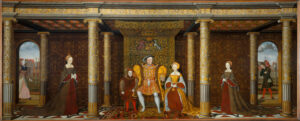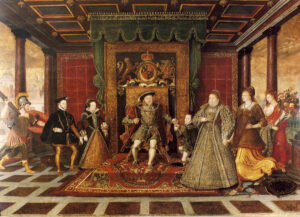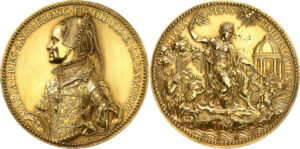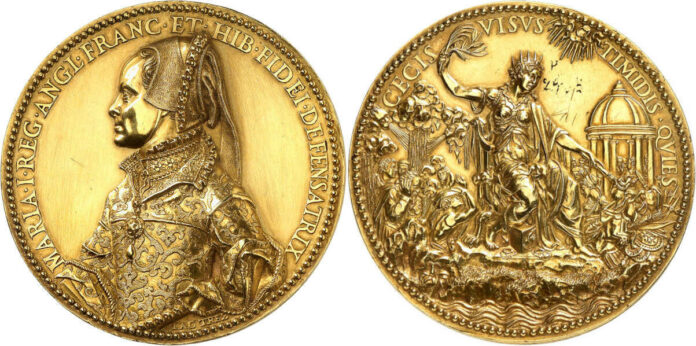Defensatrix Fidei, Defender of the Faith, this is how Mary of England referred to herself on a gold medal created by Jacopo da Trezzo around 1554, which will be auctioned off by Künker on 24 March 2023 at an estimate of 600,000 euros. Defender of the Faith – this title is not unusual. Since Henry VIII, every ruler of England held it. Pope Leo X granted it to Henry due to the latter’s harsh condemnation of Protestantism. So it was not faith that prompted Henry VIII to establish his own church in England.

The Background: The Love Life of Henry VIII
Like any Renaissance ruler, Henry VIII had entered into a marriage of convenience. His wife’s name was Catherine and she was the daughter of Isabella I of Castile and Ferdinand II of Aragon. Therefore, she was also the aunt of Charles V, and this proved to be a problem once Henry was fed up with her. The problem was that his latest flame, Anne Boleyn, refused to share his bed without an ecclesiastical ceremony. Henry VIII moved heaven and earth to have Pope Clement VII dissolve the marriage.
At the time, it was actually quite usual for the Pope to grant rulers such favors. But after the emperor’s 1527 Sack of Rome, Clement VII simply did not dare to jeopardize the fragile peace with Charles V just so that Henry could get rid of Catherine and marry Anne Boleyn.
Therefore, Henry was not granted a divorce with papal consent. Well, he just had to find a different way. Henry VIII broke away from Rome, founded the Church of England and appointed a new Archbishop of Canterbury as church primate. On 23 May 1533, the latter dutifully declared the monarch’s marriage to Catherine of Aragon to be dissolved.
Children, Denominations and a Touch of Inheritance Law
The dissolution of a marriage is not a divorce. In the case of a dissolution, the marriage is declared invalid, making every child that was born in this marriage an illegitimate bastard. As a result, 17-year-old Mary, the daughter of Henry VIII and Catherine of Aragon, lost everything. Whereas kings had previously requested her hand in marriage, she found herself deprived of her title and of her possessions, degraded to the status of lady-in-waiting to her newly born half-sister Elizabeth. Any contact with her own mother was strictly forbidden. She was not even allowed to attend her funeral in January 1536.
But Anne Boleyn also fell from grace. She was not able to deliver a male heir to the throne. Dissolving another marriage? That was not possible. Therefore, some nobles plotted an intrigue that enabled Henry VIII to have Anne Boleyn executed.
After all, the king already had his eyes on a new mistress who also refused to do his bidding without marriage vows: the devout Catholic Jane Seymour. She finally gave birth to the longed-for heir to the throne and succeeded in having Mary fall back into grace with the king – but not without making her grudgingly sign that her mother’s marriage had been invalid and that she was a bastard. In return, Mary was given a place in the line of succession: if Jane Seymour’s son Edward died without an heir, first Mary, then Elizabeth, then a member of the Brandon family (descendants of Henry’s younger sister) would inherit the throne.
The Nine Days’ Queen
In 1547, Edward ascended the throne at the age of nine. Of course, he did not make any decisions. There was a Protestant-dominated regency council for that. And this council faced serious problems when Edward fell ill with tuberculosis in 1553. We have to keep in mind that England was by no means a Protestant country in the middle of the 16th century. The Reformation had spread mainly among the clergy and some noble families. And, of course, this was not only a matter of faith but also of lucrative positions. With the arrival of the new faith, these positions had been given to Protestants. But a re-Catholicization under Mary would make them lose these positions to Catholics.
To this day, it remains unknown whether the sixteen-year-old king came up himself with the idea of changing the line of succession on his deathbed, or whether Lord Protector John Dudley was responsible for it. After all, he did not lose any time and quickly married off Edward’s heiress Jane Grey to his own son, while sending out soldiers to arrest Mary.
She had been warned and had gone to Norfolk a few days earlier. Edward died on 6 July 1553. On 9 July, Mary informed the regency council that she had taken over the rule of England. On 10 July, the council had Jane Grey proclaimed Queen of England and mobilized its army. At the same time, they ramped up the propaganda machine. Pamphlets appealed to London’s xenophobia, accusing Mary of handing over England to the “Papists and Spaniards”.
But the regency council had miscalculated the public’s response. At the head of her army, Mary marched to London in triumph. By July 19, she had already won the war. Her opponent Jane Grey went down in history as the Nine Days’ Queen.

Bloody Mary
Mary was 17 years old when her father married Anne Boleyn. Therefore, politically speaking, it had not been convenient to find her a husband. So she was still unmarried when she ascended the throne – at the age of 37! She only had a tiny window left to give birth to the longed-for heir to the throne.
Therefore, she acted hastily and imprudently when she accepted the courtesies of the Spanish ambassador. The latter already anticipated the union of England and the Habsburg Empire and persuaded Crown Prince Philip II to make the sacrifice of marrying Mary. A horror scenario for England’s Protestant nobles.
By the end of October 1553, it was decided that Mary and Philip were to marry. In early November, Mary was confronted with Wyatt’s Rebellion, a conspiracy that sought to put Elizabeth on the throne. Mary suppressed them and had 90 people involved executed. They were the first Protestants to die “for their faith”. Under Mary, 284 Protestants were burned to death. She was therefore nicknamed Bloody Mary. The fact that 190 Catholics were executed under her successor Elizabeth, on the other hand, is often readily forgotten.

A Marriage and a Medal
On 25 July 1554, Philip II of Spain married the Queen of England at Winchester Cathedral. For this occasion, a medal was minted that will be auctioned off by Künker in Osnabrück on 24 March 2023.
Its reverse features a complex depiction designed by Jacopo da Trezzo. Commissioned by Philip II, the Milanese engraver travelled to England with him. We know this from a note that says that Philip commissioned him “to present jewels of inestimable value to his bride Mary Tudor.”
For Mary, da Trezzo chose the personification of peace, who is connected to Apollo by the radiate crown. She holds a palm and an olive branch in her right hand as a sign of victorious peace. She uses the torch in her other hand to set fire to a pile of weapons. Joyful people rush over to witness the scene. In the background, we can see the temple of the Roman god Janus. Since ancient times, its closed gates have been considered a symbol of peace.
To Mary’s left, storms and lightning plague the people. They seek refuge with her, who – as her motto states – will give sight to the blind and peace to the fearful. The cube at her feet shows how she intends to do this. A cornerstone, it symbolizes permanence; the handshake depicted on it stands for unity; the scales for justice. The water probably identifies the place of peace as an island.

Another remarkable feature of this medal is the portrait on its obverse. It is strikingly similar to a portrait of her painted by Anthonis Mor van Dashorst. He was considered the favorite painter of the Spanish royal family and travelled to England with Philip II. There he did not only create Mary’s portrait but also contributed to the artistic decoration of the wedding day.
It had long been assumed that Jacopo da Trezzo used this portrait as a model for his coin design. In fact, it seems more likely that both artists made their sketches of the Queen posing in her precious dress at the same time.
Although this medal is not rare per se – there are several lead, bronze and silver versions of it – only one other gold specimen is known of, which is kept at the British Museum today.
We know that many versions of different metals and weights were created of such medals to be distributed on special occasions, whereas the value of the piece was determined by the rank of the recipient. We also know that Antoine de Granvelle, the Emperor’s Secretary of State “only” received a silver version. Therefore, it is quite likely that the golden specimens of this medal were for royal hands only – this piece might even come from the estate of Mary, Philip or Charles V.
Five Years
The rest of the story is quickly told. By marrying the Spaniard, Mary quickly lost the support of her people. Her husband was of no help. Frustrated at the fact that he could not influence the affairs of state and that ageing Mary seemed unable to produce an heir to the throne, he was conspicuous by his absence.
A hostile environment, insomnia, headaches, vision problems, depression and political concerns did the rest: five years after ascending the throne, Mary Tudor died on 6 November 1558. She was succeeded by Elizabeth I – as Philip II wrote – by his express wish. He looked forward to a productive cooperation, he told her in the same letter.
All lots of the upcoming Künker auctions can be found in the auction catalog.
For more information, visit the Künker website.
We have already looked at Henry VIII in the series Human Faces Part 38.
Here you can read more about Henry VIII’s six wives.







